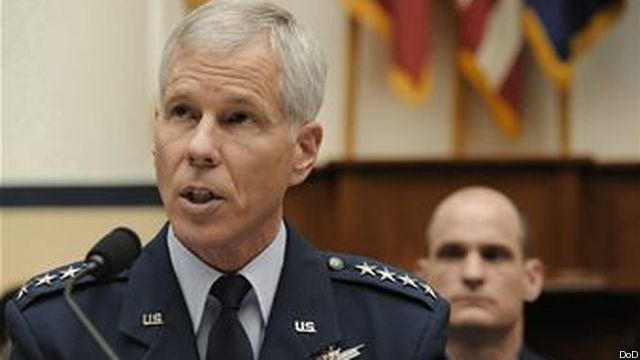Pentagon Mulls Building All-American Rocket Engines, Dropping Russian RD-180s
Posted on
CAPITOL HILL: The Pentagon’s top space officials told Congress today they have launched a study to ascertain if the United States can build its own rocket engines so expensive and large spy and GPS satellites don’t have to be launched using Russian rocket engines, as they are now.
Gen. William Shelton, head of Air Force Space Command, told the House Armed Services strategic forces subcommittee that a 45-day study is underway to determine how and if the US can build large rocket engines to loft the very large spy satellites and their GPS counterparts into geostationary orbit. Right now, the United Launch Alliance uses highly reliable and relatively cheap Russian-made RD-180 rocket engines for this crucial task.
“We are evaluating whether it is in the long-term US national security interest and significant elements of our US space industrial base to develop a next-generation US-designed and built engine,” Gil Klinger, a long-time senior space official now serving as deputy assistant secretary of Defense for space and intelligence, told the subcommittee.
The Russian “soft invasion” and annexation of Ukraine’s Crimea region has placed enormous strains on the fairly cozy relationship between the space enterprises of America and Russia. We are totally dependent on Russia to loft astronauts to the International Space Station. Although NASA broke off most relations with Russia yesterday, the space agency specifically exempted activities directly related to the station and those launches, which occur — conveniently — in Kazakhstan, not Russia.
A significant chunk of the hearing was occupied by members asking questions clearly suggested by either Elon Musk’s SpaceX, eager to get as many launches as possible as quickly as possible, or by the United Launch Alliance, eager to ensure its effective monopoly is not broken by SpaceX.
For example, Rep. Doug Lamborn asked the assembled space officials how many times the EELV program had launched and how many times it had launched successfully. The answer, as known by virtually everyone in the room, was that there have been 68 launches and 68 of them have been successful. Lamborn then helpfully asked what company had been responsible for those launches. “And United Launch Alliance was the provider,” Gen. Shelton said without losing his poker face for one moment.
Rep. Mo Brooks of Alabama waved a sheet of paper being circulated by Elon Musk’s company purporting to show that EELV’s single launch costs have more than tripled. Was it accurate, he asked the head of Space Command?
“I would tell you that information is not being used correctly,” Shelton said. Glinger backed him up and noted that one of the reasons the EELV program has grown so expensive is that almost all of the assumptions underlying it were completely wrong (especially the number of commercial satellite launches) and that left the government holding the very expensive bag.
SpaceX supporters have slammed the government for its decision in the 2015 budget to slice the number of launches in half, reducing the chances SpaceX would have to compete against ULV. The launch manifest was cut for budgetary reasons and because American satellites are lasting longer than expected, reducing the need to use the EELV program. Shelton told the subcommittee that he expects SpaceX to become certified for EELV launches quite soon and to get at least one of the seven upcoming launches if it qualifies. He also said there may be an eighth launch, though that is not clear yet.
Subscribe to our newsletter
Promotions, new products and sales. Directly to your inbox.

